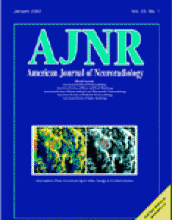Edited by Kiyonobu Ikezaki and Christopher M. Loftus. Rolling Meadows, IL: American Association of Neurological Surgeons; 2001. 213 pages.
This multiauthored monograph provides a comprehensive review of moyamoya disease. It covers all aspects of this interesting disease, including its history, classification, epidemiology, etiology, clinical findings, diagnostic evaluation, and management. It emphasizes the various revascularization procedures that have been used to treat patients with moyamoya disease. I found this monograph very easy to read and well organized.
The book can be roughly divided into two parts. The chapters in the first half of the monograph provide important background information about moyamoya disease and discuss the diagnostic evaluation of moyamoya. Three chapters are devoted to the different radiologic techniques used to diagnose this condition and examine patients. It is this first half of the book that will be of most interest and use to neuroradiologists. The second half of the book focuses on patient care and covers all of the different revascularization procedures used to treat patients with moyamoya disease.
The first three chapters lay the groundwork for the monograph. Chapters 1 and 2 provide a historical overview of the disease. Chapter 3 is an important chapter, because it defines moyamoya disease and summarizes the diagnostic criteria that have been established in Japan. Given that criteria of MR imaging and MR angiography (MRA) are an important component of the diagnostic guidelines, neuroradiologists will find the information in this chapter extremely useful when moyamoya disease is encountered. This chapter ends with a short discussion about cases that do not meet the criteria for definite moyamoya disease. This leads nicely to Chapter 4, entitled “Quasi-Moyamoya Disease,” which was written by the two editors of this monograph. This chapter nicely summarizes all of the disorders that can produce a condition similar to that of moyamoya disease. Definite moyamoya disease is the focus of the remainder of the book. Chapter 5 discusses the clinical manifestations and epidemiology of the disease, while Chapter 6 discusses what is known regarding the etiology, pathology, and genetics of moyamoya disease.
The next three chapters confront the radiologic features of moyamoya disease. The chapter regarding angiographic diagnosis is well written; however, I was disappointed in the quality of the angiographic images. Many of the images are of old cut-film angiograms and reproduced poorly. The next chapter, on MR imaging and CT scan diagnosis, also includes several images of conventional angiograms and nicely correlates the MRA and conventional angiographic findings in a few cases. Overall, the quality of images in this chapter is much better, but a few of the images are of only average quality, at best. The authors of this chapter indicate that the basic theory of MRA is beyond the scope of this book, but they go on to discuss the differences between time-of-flight (TOF) and phase-contrast (PC) MRA. In this discussion, they state that 3D-PC MRA is uniquely sensitive to slow flow but do not mention that this depends on the velocity-encoding gradient (venc) selected. Nevertheless, they correctly indicate that 3D-TOF MRA is the technique most commonly used in practice, and all of the MRA images in this chapter are 3D-TOF. Overall, neuroradiologists will find this chapter useful, especially the short discussion and examples illustrating the use of MRA to follow up patients after bypass surgery. The next chapter discusses the use of positron emission tomography (PET) and single-photon emission CT (SPECT) in moyamoya patients both before and after surgery. In this chapter, the authors summarize their experience with these two techniques in the form of several complicated graphs. The information in this chapter is interesting and useful; however, this chapter does not read as smoothly as the rest of the book.
The remainder of the monograph confronts therapeutic strategies in patients with moyamoya disease. Chapter 10 discusses the United States experience with moyamoya disease, focusing on Dr. Loftus’ experience at the University of Iowa. The chapter also summarizes the findings of other United States centers that have had significant experience with moyamoya disease, while acknowledging that the United States experience is limited owing to the rarity of moyamoya in North America.
Chapter 11 concerns management strategies and is subdivided into four parts. Each part is written by different authors, which basically makes each part an individual chapter. I found Parts 2 and 3 especially useful, because they discuss the different revascularization procedures, postoperative examinations, and follow-up imaging. By using conventional angiograms, MR angiograms, and PET images, Part 3 nicely illustrates the expected postoperative imaging findings after various revascularization procedures. This section also illustrates examples of treatment failures and their management.
The next three chapters provide an overview on the indications and technical details of the different revascularization procedures with chapters devoted to direct bypass surgery, indirect bypass procedures, and omental transplantation. These chapters elaborate on information introduced in Chapter 11. Although brief, these chapters probably provide more technical details about the surgical procedures than will be of interest to most neuroradiologists. The book concludes with a short chapter about anesthetic management of patients with moyamoya disease.
In my opinion, this monograph is “must” reading for any physician involved in the care of patients with moyamoya disease. It is short and very easy to read but still provides a comprehensive state-of-the-art review of the disease. Although this monograph was primarily intended for a neurosurgical audience, any neuroradiologist or neurologist with an interest in moyamoya disease will find this book to be interesting and worthwhile. This book can be recommended for purchase by institutional libraries and by clinicians (neurosurgeons, neuroradiologists, and neurologists) who frequently see moyamoya disease in their practice.
- American Society of Neuroradiology












